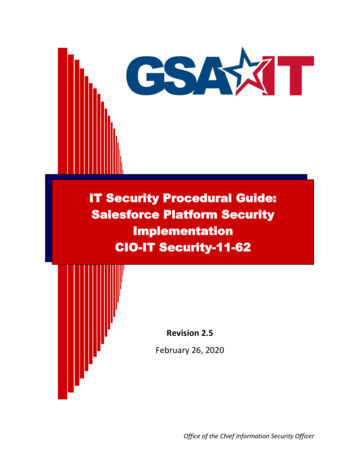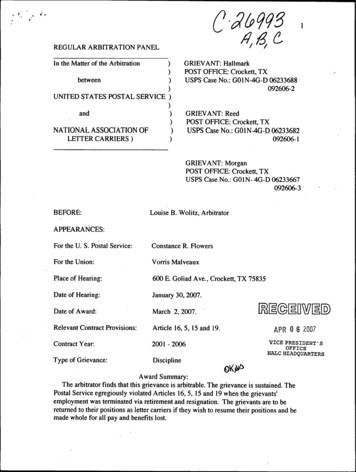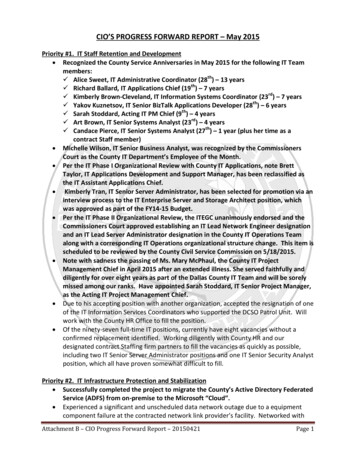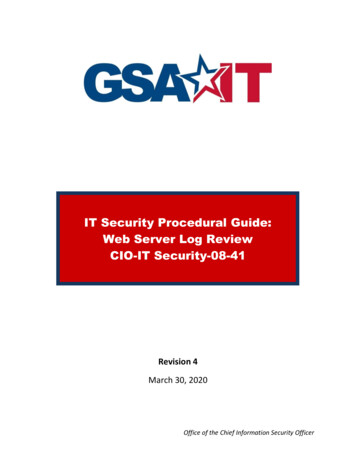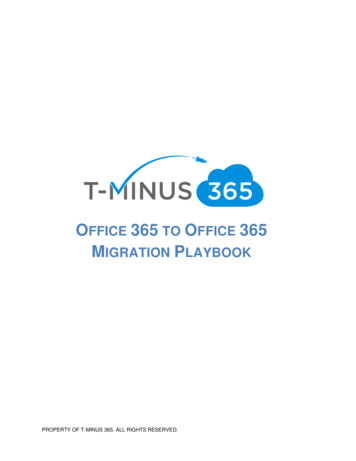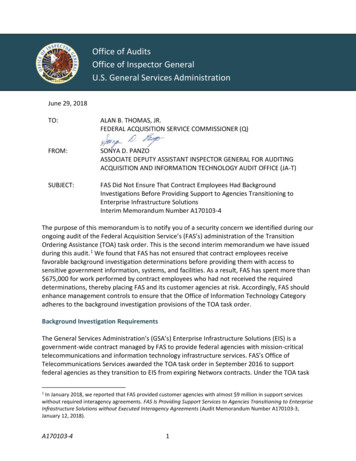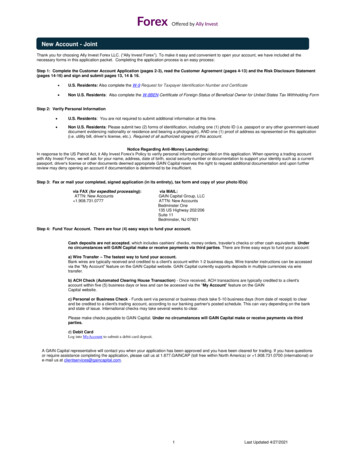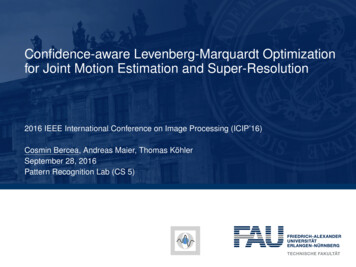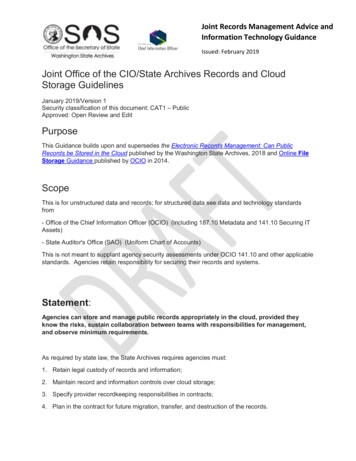
Transcription
Joint Records Management Advice andInformation Technology GuidanceIssued: February 2019Joint Office of the CIO/State Archives Records and CloudStorage GuidelinesJanuary 2019/Version 1Security classification of this document: CAT1 – PublicApproved: Open Review and EditPurposeThis Guidance builds upon and supersedes the Electronic Records Management: Can PublicRecords be Stored in the Cloud published by the Washington State Archives, 2018 and Online FileStorage Guidance published by OCIO in 2014.ScopeThis is for unstructured data and records; for structured data see data and technology standardsfrom- Office of the Chief Information Officer (OCIO) (including 187.10 Metadata and 141.10 Securing ITAssets)- State Auditor's Office (SAO) (Uniform Chart of Accounts)This is not meant to supplant agency security assessments under OCIO 141.10 and other applicablestandards. Agencies retain responsibility for securing their records and systems.Statement:Agencies can store and manage public records appropriately in the cloud, provided theyknow the risks, sustain collaboration between teams with responsibilities for management,and observe minimum requirements.As required by state law, the State Archives requires agencies must:1. Retain legal custody of records and information;2. Maintain record and information controls over cloud storage;3. Specify provider recordkeeping responsibilities in contracts;4. Plan in the contract for future migration, transfer, and destruction of the records.
Joint Records Management Advice andInformation Technology GuidanceIssued: February 2019Records in the cloud must:1. Retain accountability, integrity, compliance, authenticity, and reliability;2. Be available, searchable, and retrievable;3. Be protected from unauthorized deletion;4. Be retained for the minimum retention period;5. Be destroyed/transferred in accordance with the appropriate records retention schedule.Minimum requirements for compliance:1. Agency Retains Legal Custody – Agencies must not transfer legal ownership of the publicrecords to the cloud service provider or other non-government entity. This satisfies the “legalcustody” requirements in WAC 434-615-020.2. Agency Controls Access – Agencies need to control who has access to their public recordswhile they are stored with the third-party cloud service provider. This satisfies the “physicalcustody” requirements in WAC 434-615-020.3. Agency Complies with State IT Security Polices -- Agencies must ensure that the cloudservice provider, applications and data comply with the OCIO IT Security Standards 141.10.Teams that should collaborate on cloud records management: Records and Information ManagementPublic RecordsInformation TechnologyRisk ManagementInformation/Data GovernanceSecurityContracts and legal counselPrivacyRisks:The creation, storage, and maintenance of a record in the cloud provides a variety of business andlegal risks when asserting the accuracy and validity of records. Planning for the cloud must considerthese risks and staff should conduct a risk and record assessment before entering into anyagreement with a cloud vendor. This is important because it is often difficult to conduct on-site
Joint Records Management Advice andInformation Technology GuidanceIssued: February 2019assessments or investigations of a cloud provider or work backwards to correct human behaviors inrecord creation and storage.Recordkeeping Considerations for the Cloud1. Legal compliance2. Unauthorized access to records3. Loss of access to records4. Limit customization of the cloud5. Establish record controls in the cloud6. Do Your Regular Records Inventory7. Vendor going out of business8. Have an exit strategy9. Establish a Continuity Plan in the event of disaster10. The evidential value of records may be damaged11. The cloud vendor disposes of digital records without the approval of the agency12.) Other jurisdictions' laws may affect obligations for retention and management1.) Legal ComplianceSending or storing records outside of Washington State may require records to conform to localrecord and public disclosure laws. It is important to understand where the record will be storedbecause local jurisdictions may require additional disclosure burdens for the agency. For example, itis possible for the agency to need to disclose records held within another state according to theirpublic disclosure laws.Before entering into agreements with cloud computing providers, agencies should investigate anylegislative impediments to the transfer or storage of records outside the physical boundaries of theState. There is a risk that when cloud computing providers send records outside the geographicboundaries of Washington State they might fail to comply with records management RCW and WACrequirements.2.) Unauthorized Access to Records
Joint Records Management Advice andInformation Technology GuidanceIssued: February 2019Security should be a primary concern when protecting records in the cloud. It is highly recommendedto follow OCIO security standards for cloud computing.The disclosure and processing of data and information by third-party processors of the cloud vendorfor data mining or other marketing efforts should be avoided. Cloud vendors should be required toobtain prior approval and written permission before engaging in the use of third-party processors tointeract with records and information stored in the cloud to prevent the unauthorized disclosure ofpersonal information, protected health information, proprietary information, and controlledinformation.3.) Loss of Access to RecordsAs cloud computing services are provided over the internet, it is more likely that there may be someperiods of disruption to service where records are unavailable. For business activities wherecontinuous access is imperative, the impact of a loss of access may be severe. Cloud storage maynot be appropriate in these situations. Poor record controls may make it difficult to distinguish anofficial record from duplicate or near-duplicate records. Using the cloud requires seriousconsideration of proper records control to mitigate these risks.4.) Limit Customization of the CloudAs with all electronic information systems, it is best practice to limit customization. Customizationsgenerally lead to loss of service as personnel change or systems need to be upgraded. Generally,use standard approaches with repeatable activities to safeguard the system and improve useracceptance. Avoiding customization does not mean for the agency to allow for the uncontrolleddesign of the cloud environment, rather it means it should be planned according to the businessactivities along with the impact upon other business activities.5.) Establish Record Controls in the CloudInformation lifecycle management is essential in the cloud environment. Records should not beintroduced into the cloud without specific controls in place. It is recommended that records andinformation management processes be implemented to build accountability, integrity, compliance,availability, retention, disposition, and transparency. This means integration of file plans, recordsmetadata standards, records naming standards, and other record controls as necessary. Automationshould be encouraged and used if available. Utilization of records metadata will provide the ability tocreate records in a controlled and predictable manner, place specific retention standards on therecord, and allow for disposition in a controlled and defensible manner. Additionally, metadata, ifenabled, would allow for version control of records and assist in retrieval of records during publicrecords disclosure activities.Controls to prevent additions, modifications, or deletions of records by unauthorized parties will helpdemonstrate the authenticity, maintain the chain of custody, and help protect the evidentary value ofthe record (WAC 434-662-060).
Joint Records Management Advice andInformation Technology GuidanceIssued: February 20196.) Do Your Regular Records InventoryBusiness and service components change over time, as do our needs from electronic storagesystems. Inventory and assessment allows the agency to adjust its cloud needs based on empiricalevidence gathered in the process. The assessment should map data inputs and outputs, establishevent triggers, understand the nature of records, and determine if the cloud is being utilized in themost efficient manner. Assessments should also validate access, security, and control.Assessments should be conducted using specific auditing standards such as ISO 15489-1. Refer toguidance from the State Archives, Privacy Office and OCIO7.) Vendor Going Out of BusinessVendors may go out of business during the contract period. The vendor could also be taken over byanother company. The new company may not honor the contract or provide the agreed level ofservice. While this is possible due to the nature of constant changes in IT, it is rare. Migrationplanning can assist with migration from one vendor to another, but it must be assumed servicedisruption could result.8.) Have an Exit StrategyBefore signing a contract with a vendor for the cloud, the agency should plan for migration, dataportability and future usability of records from the cloud. Portability planning would determineacceptable media formats for records in the cloud. Formats should be non-proprietary and use openarchitecture to improve the chance of migration and reduce the threat of records loss. It will beimportant to establish emergency protocols and storage locations should the vendor go out ofbusiness. Rapid transfer of records may not be possible. Essential records, those needed forcontinuing of agency functions, need to be identified and migrated first.Vendors may conduct upgrades to hardware and/or software which is not compatible with agencysystems. Contracts should specifically speak to this risk and outline notification procedures for theagency to assess and plan for any migration requirements needed during an upgrade. Not doing someans there is a risk of data loss or of records not being readable upon return.9.) Establish a Continuity Plan in the Event of DisasterCloud vendors have similar risks to disasters as any agency. These risks should be mitigatedthrough proper continuity planning and risk management. It is important to identify all essentialrecords in the cloud and categorize them according to the specific timeline needs of the agency aftera disaster in the cloud. Understand the vendor’s backup plans and locations. If the vendor only hasone storage location and it's in a high risk zone for disaster, consider a different vendor. Most cloudvendor’s today stage storage sites in multiple locations with built-in redundancies to account fordisaster. Cyber attacks should also be addressed in continuity planning.
Joint Records Management Advice andInformation Technology GuidanceIssued: February 201910.) The Evidentiary Value of Records May be DamagedAgency cloud records need to be managed in such a way that they can be shown to be authentic(free from tampering) and reliable.11.) The Cloud Vendor Disposes of Digital Records without the Approval of the AgencyAt no time does a vendor have the authority to dispose of records in the cloud without prior writtenauthorization. If authorized in a contract, the contract must specify appropriate methods for disposalby the vendor based on security classifications. The vendor must provide evidence of dispositionactivities through audit records or systems event history logs.It is common for vendors to replicate records for multiple backups by sending copies to storage sitesat different locations. This can mean that time-expired records are not properly deleted from everyserver held at every site. This poses a serious risk where there is a specific requirement forinformation to be destroyed, such as records containing personal or confidential information orrecords exceeding retention standards. It is important to outline in the contract that once dispositionactivities are initiated by the agency, all record copies are destroyed as a result of the action, nomatter the location.12.) Other jurisdictions' laws may affect obligations for retention and managementCloud services very often involve the storage of personal information outside the US, or access to itfrom outside the US. Though Washington law does not currently address this question, carefulinquiries should be made before entering into cloud services arrangements involving personalinformation storage in jurisdictions where control of data cannot be assured.When collaborating with other jurisdictions such as the Province of British Columbia, the State ofOregon, or certain federal agencies, there may well be specific records retention or storagerequirements that apply -- and that differ from the requirements in Washington state. For example,BC provincial agencies are advised that BC law prohibits access to or disclosure of personalinformation outside Canada. Agencies should consider how, where and by whom records of such acollaboration will be stored, shared and disposed of.
Joint Records Management Advice andInformation Technology GuidanceIssued: February 2019Records and Information Management Cloud ReadinessChecklistThis is not an exhaustive list. It is adapted from the Washington State Department of Health (DOH)Records and Information Readiness Process for onboarding into Enterprise Content ManagementSystems. Additional needs may be identified. It is also recommended that readiness activities utilizethe DOH Records Analysis Standard to provide a consistent methodology for cloud development.1. The agency owns records placed in the cloud. Ensure agency complies with Custody of Public Records (434-615 WAC)Ensure agency complies with records requirement found in Preservation and Destruction ofPublic Records (40.14 RCW)Ensure agency complies with electronic records requirements found in Preservation ofElectronic Records (434-662 WAC)2. Records in the cloud must be authentic, accurate, and trusted Map records to locations - see e.g. Privacy Office Data Mapping ChecklistDetermine the adequacy of cloud vendor’s audit logs and system logsDetermine cloud securityBe aware of third party processors3. Records in the cloud should be complete and unaltered Consider the impact of altered recordsConsider the format of records created or stored for migration4. Records in the cloud should be secured from unauthorized access, alteration, and deletion Consider who has access to, and use of, agency recordsAssess the provider viabilityConsider the risk of incomplete and unauthorized destruction of records5. Records in the cloud should be retrievable and readable Consider the readability and usability of records created in the cloudEnsure records can be retrievedEvaluate the impact of corrupted recordsEstablish controlled languages to allow for accurate creation, storage, and retrieval ofrecordsConsider the metadata requirements needed to identify and retrieve recordsConsider establishing file and record naming standards6. Records in the cloud should be related to other relevant records
Joint Records Management Advice andInformation Technology GuidanceIssued: February 2019 Consider the need for metadata maintenance and managementUnderstand how records in the cloud relate to other records stored at the agencyApply records classification through the establishment of file plansGlossary of TermsCloud Service / Cloud Service providerCloud computing is defined by the National Institute of Standards and Technology (NIST) as:“a model for enabling ubiquitous, convenient, on-demand network access to a shared pool ofconfigurable computing resources (e.g., networks, servers, storage, applications, and services) thatcan be rapidly provisioned and released with minimal management effort or service providerinteraction.”Mobile DeviceAny hand-portable device capable of text, voice, email, instant messaging (“IM”), photo messagingor other types of data communication. This policy is not meant to apply to: cars, boats, airplanes,laptop computers, desktop computers, unpiloted aerial vehicles (drones), GPS receivers, radios.Online File Storage ServiceA file hosting service, cloud storage service, or online file storage provider that hosts user files viathe Internet. Users can upload files that can be accessed over the internet from other computers andmobile devices, by the same user or other designated users. Examples include but are not limited to:Box.com, OneDrive for Business.Public Records RequestA request under chapter RCW 42.56 for the inspection and copying of a public record. An agency isprohibited from destroying or erasing a record, even if it is about to be lawfully destroyed under aretention schedule, if a public records request has been made for the record. Agencies are requiredto retain potentially responsive records until the public record request is resolved. Where notified ofa public records request, employees must, with regard to potentially responsive records, suspendthe destruction of records, conduct a reasonable search for records, and gather or segregaterecords so they may be reviewed and, if necessary, produced. Like other records, records createdor stored with an online file storage service are subject to the requirements of the Public RecordsAct.Legal HoldA legal hold is a communication issued as a result of current or anticipated litigation, public recordsrequest, audit, government investigation or other such matter that suspends the normal disposition
Joint Records Management Advice andInformation Technology GuidanceIssued: February 2019or processing of records. The specific communication to agency business or IT organizations mayalso be called a “hold,” “preservation order,” “suspension order,” “freeze notice,” “hold order,” or“hold notice.Further Reference: Securing Information Technology Assets141Securing Information Technology Assets Standards141.10Media Handling and Data Disposal Best Practices141.10.10Open Data Planning187Metadata Standard187.10Geospatial Data Management Policy160.00Records Retention Schedules (State Archives)Public Records Act Definitions (RCW 42.56.010)Preservation and Destruction of Public Records (RCW 40.14.010)Custody of Public Records (WAC 434-615)Standards for the Accuracy, Durability, and Permanence of Public Records (WAC 434-660)Preservation of Electronic Public Records (WAC 434-662)
1. Legal compliance 2. Unauthorized access to records. 3. Loss of access to records. 4. Limit customization of the cloud 5. Establish record controls in the cloud 6. Do Your Regular Records Inventory. 7. Vendor going out of business. 8. Have an exit strategy 9. Establish a Continuity Plan
